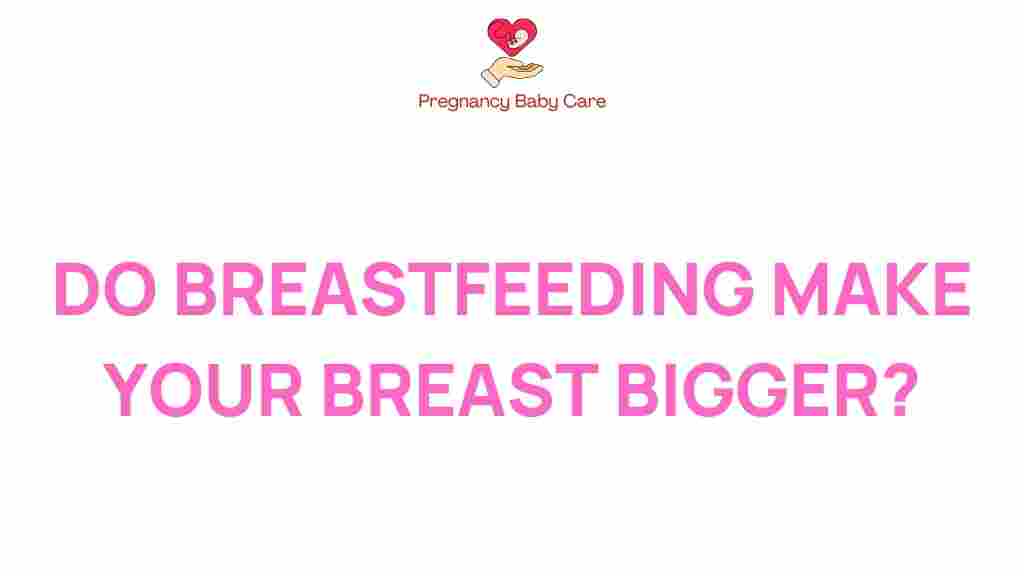Does Breastfeeding Truly Enhance Breast Size?
Breastfeeding is a natural and essential part of maternal care, often surrounded by various myths and misconceptions. One common question many new mothers ponder is whether breastfeeding can enhance breast size. In this article, we will explore the relationship between breastfeeding and breast size, examining the body changes that occur postpartum, and uncovering the surprising truths behind this well-discussed topic.
Understanding Breast Size and Its Changes Postpartum
To understand if breastfeeding affects breast size, it’s crucial to first recognize the factors that contribute to breast size in general. Breast size is determined by several factors, including:
- Genetics: Family history plays a significant role in determining breast size.
- Body Weight: Weight gain or loss can affect breast size, as breasts are composed of glandular tissue and fat.
- Hormones: Hormonal changes during puberty, menstruation, pregnancy, and lactation can influence breast size.
During pregnancy, many women experience an increase in breast size due to hormonal changes and the preparation of the body for nursing. After childbirth, whether a mother chooses to breastfeed or not can lead to further changes.
The Role of Breastfeeding in Breast Size
Breastfeeding itself does not directly enhance breast size; however, it can influence the size and shape of breasts in several ways. Here’s a look at how breastfeeding interacts with breast size:
- Temporary Swelling: During lactation, breasts may swell due to milk production, giving them a fuller appearance.
- Fat Redistribution: Postpartum changes can lead to a redistribution of fat, which may alter breast shape.
- Reduced Glandular Tissue: After weaning, some women may notice a reduction in breast fullness as glandular tissue decreases.
So, while breastfeeding may cause temporary increases in size, it doesn’t necessarily lead to permanent changes in breast size in the long term.
Myths About Breastfeeding and Breast Size
There are several myths surrounding breastfeeding and breast size that can lead to misconceptions. Here are some common myths and the truths behind them:
- Myth 1: Breastfeeding makes breasts sag.
Truth: Factors such as genetics and aging are more responsible for breast sagging than breastfeeding alone. - Myth 2: Larger breasts produce more milk.
Truth: Milk production is determined by glandular tissue, not breast size. - Myth 3: Breastfeeding will keep your breasts large permanently.
Truth: Post-lactation, breast size may return to pre-pregnancy measurements or change due to other factors.
Health Benefits of Breastfeeding
Regardless of its effects on breast size, breastfeeding offers numerous health benefits for both mother and child. These benefits include:
- For the Baby:
- Provides optimal nutrition and immune support.
- Reduces the risk of infections and chronic conditions.
- Promotes healthy weight gain.
- For the Mother:
- Helps in postpartum recovery by promoting uterine contraction.
- Reduces the risk of breast and ovarian cancers.
- Can aid in weight loss postpartum.
Moreover, breastfeeding fosters a unique bond between mother and child, contributing to emotional well-being.
Body Changes After Lactation
After weaning, women may notice various changes in their bodies, including:
- Shifts in Breast Shape: Breasts may appear less full as milk production ceases.
- Changes in Skin Elasticity: The skin may stretch and then tighten, affecting appearance.
- Weight Fluctuations: Changes in body weight can influence breast size.
It’s essential for women to understand that these changes are normal and part of the postpartum journey.
Tips for Managing Body Changes During and After Breastfeeding
For mothers looking to manage their body changes during and after breastfeeding, consider the following tips:
- Stay Hydrated: Drinking plenty of water can help maintain skin elasticity.
- Maintain a Balanced Diet: Eating a nutrient-rich diet supports overall health and recovery.
- Exercise: Regular physical activity can help tone muscles and improve body image.
- Wear Supportive Bras: Well-fitted bras can provide comfort and support during breastfeeding.
Common Concerns and Troubleshooting
Many women may have concerns about breastfeeding and its effects on their bodies. Here are some common concerns and tips for addressing them:
- Concern: Breast Pain or Discomfort
Tip: Ensure proper latch and consider consulting a lactation consultant. - Concern: Low Milk Supply
Tip: Stay hydrated and nurse frequently to stimulate supply. - Concern: Changes in Breast Appearance
Tip: Understand that body changes are normal, and consider discussing concerns with a healthcare provider.
For more personal tips on nursing and lactation, check out this helpful resource.
Conclusion
In conclusion, the relationship between breastfeeding and breast size is complex. While breastfeeding can temporarily enhance breast fullness due to milk production, it does not guarantee long-term increases in breast size. Additionally, many myths surrounding breastfeeding can lead to misunderstandings about its effects on the body.
Ultimately, the health benefits of breastfeeding for both mother and child are significant and far outweigh concerns about breast size. Embracing the body changes that occur during this transformative time is crucial for maternal care and self-acceptance. By understanding the truths surrounding breastfeeding, new mothers can focus on nurturing their babies and themselves, celebrating the incredible journey of motherhood.
For more information on breastfeeding and maternal health, visit this external site.
This article is in the category Health and created by PregnancyBabyCare Team
